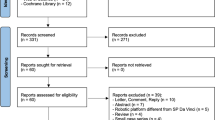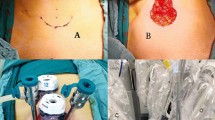Abstract
Introduction
Versius Surgical System (CMR Surgical, Cambridge, UK) is a novel tele-operated robotic surgical system designed to assist surgeons for minimally invasive surgery which is gaining momentum in the world of robotic surgery. We describe our single centre experience with Versius and report the advantages and challenges posed by this new robotic system in a series of 53 extraperitoneal robotic assisted laparoscopic prostatectomies (eRALP) for prostate cancer (PCa).
Materials and methods
Data of 53 eRALP performed with Versius in our centre were collected and analysed, Descriptive statistics were used to report our results.
Results
In 16 months we performed 53 eRALP: 18 (34%) with PLND, 33 (62%) nerve sparing cases. Mean setup time was 15 min, mean console time was 100 min and mean operative time was 130 min. We observed a substantial reduction of console time and set-up time after only 5 procedures. In the first 4 procedures, the dissection of the neurovascular bundle was performed laparoscopically, to switch back to robotic assisted approach afterwards. No major system failures were observed. No major intra-operative and post-operative complications occurred. Mean follow-up time was 9 months (range 3–15 months); no patients experienced biochemical recurrence or metastatic progression over this period, 8 (15%) patients had adjuvant radiotherapy based on unfavourable pathology report (positive surgical margins or positive limphnodes).
Conclusion
This represents to our knowledge the largest extraperitoneal RALP case series with Versius, and it aims to provide solid clinical proof of the safety, effectiveness and versatility of this innovative system. In our experience, this platform represents a good option for every urologic surgeon who wants to start a robotic programme and it appears particularly suitable for urologists with a large laparoscopic expertise.
This is a preview of subscription content, access via your institution
Access options
Subscribe to this journal
Receive 4 print issues and online access
$259.00 per year
only $64.75 per issue
Buy this article
- Purchase on Springer Link
- Instant access to full article PDF
Prices may be subject to local taxes which are calculated during checkout


Similar content being viewed by others
Data availability
The data that support the findings of this study are available on request from the author FD.
References
Babbar P, Hemal A. Robot-assisted urologic surgery in 2010—advancements and future outlook. Urol Ann. 2011;3:1–7. https://doi.org/10.4103/0974-7796.75853.
Pandolfo SD, Del Giudice F, Chung B, Manfredi C, De Sio M, Damiano R, et al. Robotic assisted simple prostatectomy versus other treatment modalities for large benign prostatic hyperplasia: a systematic review and meta-analysis of over 6500 cases. Prostate Cancer Prostatic Dis. 2022. https://doi.org/10.1038/s41391-022-00616-4.
Collins D, Paterson HM, Skipworth RJE, Speake D. Implementation of the Versius robotic surgical system for colorectal cancer surgery: first clinical experience. Color Dis. 2021;23:1233–8. https://doi.org/10.1111/codi.15568.
Fuschi A, Pastore AL, Al Salhi Y, Martoccia A, De Nunzio C, Tema G, et al. The impact of radical prostatectomy on global climate: a prospective multicentre study comparing laparoscopic versus robotic surgery. Prostate Cancer Prostatic Dis. 2023. https://doi.org/10.1038/s41391-023-00672-4.
Soumpasis I, Nashef S, Dunning J, Moran P, Slack M. Safe implementation of a next-generation surgical robot: first analysis of 2,083 cases in the versius surgical registry. Ann Surg. 2023. https://doi.org/10.1097/SLA.0000000000005871.
Alkatout I, Salehiniya H, Allahqoli L. Assessment of the versius robotic surgical system in minimal access surgery: a systematic review. J Clin Med. 2022;11. https://doi.org/10.3390/jcm11133754.
Koukourikis P, Rha KH. Robotic surgical systems in urology: what is currently available? Investig Clin Urol. 2021;62:14–22. https://doi.org/10.4111/icu.20200387.
Thomas BC, Slack M, Hussain M, Barber N, Pradhan A, Dinneen E, et al. Preclinical evaluation of the versius surgical system, a new robot-assisted surgical device for use in minimal access renal and prostate surgery. Eur Urol Focus. 2021;7:444–52. https://doi.org/10.1016/j.euf.2020.01.011.
Rocco B, Turri F, Sangalli M, Assumma S, Piacentini I, Grasso A, et al. Robot-assisted radical prostatectomy with the versius robotic surgical system: first description of a clinical case. Eur Urol Open Sci. 2023;48:82–3. https://doi.org/10.1016/j.euros.2022.11.019.
Huddy JR, Crockett M, Nizar AS, Smith M, Malki M, Barber N, et al. Experiences of a “ COVID protected ” robotic surgical centre for colorectal and urological cancer in the COVID-19 pandemic. J Robot Surg. 2022;16:59–64. https://doi.org/10.1007/s11701-021-01199-3.
Hussein A, Mohsin R, Qureshi H, Leghari R, Jing Z, Ramahi YO, et al. Transition from da Vinci to Versius robotic surgical system: initial experience and outcomes of over 100 consecutive procedures. J Robot Surg. 2022:419–26. https://doi.org/10.1007/s11701-022-01422-9.
De Nunzio C, Brassetti A, Cancrini F, Prata F, Cindolo L, Sountoulides P, et al. Physical inactivity, metabolic syndrome and prostate cancer diagnosis: development of a predicting nomogram. Metabolites. 2023;13. https://doi.org/10.3390/metabo13010111.
Bokhorst LP, Valdagni R, Rannikko A, Kakehi Y, Pickles T, Bangma CH, et al. A decade of active surveillance in the PRIAS study: an update and evaluation of the criteria used to recommend a switch to active treatment. Eur Urol. 2016;70:954–60. https://doi.org/10.1016/j.eururo.2016.06.007.
Dindo D, Demartines N, Clavien P. Classification of surgical complications. Ann Pediatr Surg. 2004;240:205–13. https://doi.org/10.1097/01.sla.0000133083.54934.ae.
Scarcia M, Zazzara M, Divenuto L, Cardo G, Portoghese F, Romano M, et al. Extraperitoneal robot-assisted radical prostatectomy: a high-volume surgical center experience. Minerva Urol Nefrol. 2018;70:479–85. https://doi.org/10.23736/S0393-2249.18.03114-4.
Haig F, Medeiros ACB, Chitty K, Slack M. Usability assessment of Versius, a new robot-assisted surgical device for use in minimal access surgery. BMJ Surg Inter Heal Technol. 2020;2:1–8. https://doi.org/10.1136/bmjsit-2019-000028.
Sood A, Grauer R, Diaz-Insua M, Tewari KA, Hemal AK, Shrivastava A, et al. 15-year biochemical failure, metastasis, salvage therapy, and cancer-specific and overall survival rates in men treated with robotic radical prostatectomy for PSA-screen detected prostate cancer. Prostate Cancer Prostatic Dis. 2023;26:778–86. https://doi.org/10.1038/s41391-023-00674-2.
Lebeau T, Rouprêt M, Ferhi K, Chartier-Kastler E, Richard F, Bitker MO, et al. Assessing the complications of laparoscopic robot-assisted surgery: the case of radical prostatectomy. Surg Endosc. 2011;25:536–42. https://doi.org/10.1007/s00464-010-1210-z.
Author information
Authors and Affiliations
Contributions
All authors discussed the results and contributed to the final manuscript. F. Dibitetto, C. Fede Spicchiale, S. Sansalone, R. Castellucci and M. De Dominicis developed the idea and the concept of the study. F. Dibitetto, A. Akhundov, L. Defidio collected the data and analysed the results. F. Dibitetto and C. Fede Spicchiale drafted and wrote the article. M. De Dominicis performed the operations and supervised the project.
Corresponding author
Ethics declarations
Competing interests
The authors declare no competing interests.
Additional information
Publisher’s note Springer Nature remains neutral with regard to jurisdictional claims in published maps and institutional affiliations.
Rights and permissions
Springer Nature or its licensor (e.g. a society or other partner) holds exclusive rights to this article under a publishing agreement with the author(s) or other rightsholder(s); author self-archiving of the accepted manuscript version of this article is solely governed by the terms of such publishing agreement and applicable law.
About this article
Cite this article
Dibitetto, F., Fede Spicchiale, C., Castellucci, R. et al. Extraperitoneal robot assisted laparoscopic prostatectomy with Versius system: single centre experience. Prostate Cancer Prostatic Dis (2024). https://doi.org/10.1038/s41391-024-00810-6
Received:
Revised:
Accepted:
Published:
DOI: https://doi.org/10.1038/s41391-024-00810-6



